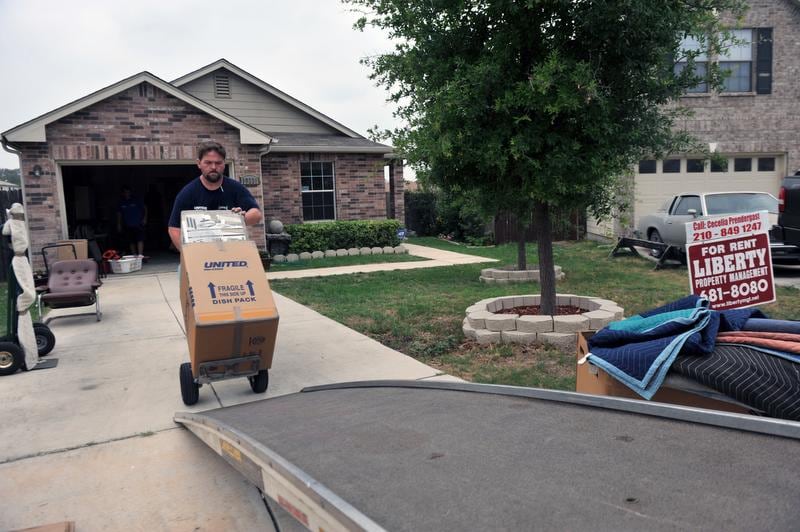Making the Move.mil website more user-friendly and possibly spreading at least some moves more evenly throughout the year are a few of the things defense transportation officials are looking at to improve the process of moving household goods for service members, as the program that manages service members’ household goods undergoes its own relocation of sorts.
The Defense Personal Property Program, or DP3, will be managed by U.S. Transportation Command after more than 59 years under the stewardship of the Army, in various forms.
Although DP3 met customers’ requirements, the new setup will improve effectiveness and efficiency, officials said.
“We’re more aware than ever that it’s not about the stuff we move, but it’s about the families we relocate and how you deliver exceptional customer service,” said Air Force Gen. Darren McDew, head of TRANSCOM, who directed the consolidation in June.
Service members, DoD civilians and their families will see some improvements by next summer’s moving season, but “it will probably take us two years to get to the point where they say, ‘Wow, this is much better than it was,’ “ said Army Col. Ralph Lounsbrough, personal property division chief in TRANSCOM.
Officials will look at persistent issues in new ways. One example: The vast majority of military moves take place in the summer, with moves in late June and early July invariably putting a strain on the capacity of industry to provide the trucks and personnel (such as packers).
TRANSCOM officials are discussing with service officials the possibility of spreading out the moves, said Lounsbrough.
“It’s all about taking care of relocating families,” he said. “We’re not trying to look at how do we move a family of four in the middle of October after the school year has started. But there are also people that move during the peak season that maybe are single, that don’t necessarily gain anything by moving in the summer. Maybe there’s some opportunity to spread some of that business over the rest of the year, as well.
“A lot of that is DoD personnel decisions, not so much us, but we’ll try to work with them to see if there are some opportunities to spread that volume out a little more than it is today.”
Before the DP3 move, TRANSCOM already directed the Defense Personal Property System, or DPS, which is the web interface that drives the moving process.
ON THE MOVE
Most of the planned updates to Move.mil will be place in time for the peak moving season next summer, officials said. Service members, military services’ transportation offices, moving companies and others use that interface connect to carry out moves, handle claims and manage other parts of the process.
Lounsbrough called the current setup “clunky for the average user.” One of the drawbacks: Every move requires users to start from square one, he said, despite many users moving once every two or three years. A possible model to emulate, he said, would be tax software that pulls in previous years‘ data automatically.
They’re also looking at adapting the technology for mobile devices, he said.
No plans call for replacing the installation transportation or traffic management office as the primary point of contact for movers with problems, officials said. Those offices are still key in the process. Issues that can’t be solved locally would move up the TRANSCOM ladder.
The general consensus is that there have been improvements in household goods moves over the past few peak seasons, Lounsbrough said, but that “every year, as good as we can get this program, there will still be some bad moves. I don’t think we’ll ever completely get rid of that, but we can make it better, and that’s what we’re trying to do.”
Officials at TRANSCOM have been talking with industry and service officials, including the senior enlisted advisers, about planned changes. They’re also working with industry on capacity issues, and will try to remove some of the bureaucracy to help industry provide better service to service members, Lounsbrough said.
Officials are trying to streamline the 640-page regulation covering household goods moves, he said.
“We are very optimistic regarding the new structure. For years we have had to approach three different entities regarding issues having to do with personal property,” said Charles White, senior vice president of the International Association of Movers.
“Many times there was overlap concerning responsibilities and it made advocating for change/improvement difficult at best. IAM believes that having one entity that is responsible for almost all aspects of the personal property program will be a positive for all of the stakeholders [service members, industry and DOD] involved in the Defense Personal Property Program,” he said.
Karen has covered military families, quality of life and consumer issues for Military Times for more than 30 years, and is co-author of a chapter on media coverage of military families in the book "A Battle Plan for Supporting Military Families." She previously worked for newspapers in Guam, Norfolk, Jacksonville, Fla., and Athens, Ga.




